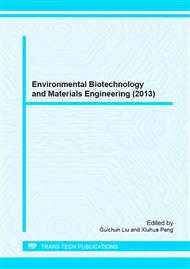[1]
X. Liu. Study of main factors affecting the oxygen mass transfer in aeration technology [D]. DaLian: Dalian University of Technology, (2008).
Google Scholar
[2]
L.P. Zhou, H.T. Zhao, Z.R. Liu, et al. Research on the effects of water quality on the oxygen mass transfer [J]. Journal of North University of China, 2010, 31(1): 45-49.
Google Scholar
[3]
Marupatch Jamnongwong, Nicolas Dietrich, Gilles Hébrard et al. Experimental study of oxygen diffusion coefficients in clean water containing salt, glucose or surfactant: Consequences on the liquid-side mass transfer coefficients[J]. Chemical Engineering Journal, 2010, 165: 758-768.
DOI: 10.1016/j.cej.2010.09.040
Google Scholar
[4]
F. Garcı´a-Ochoa, E. Go´ mez Castro. Estimation of oxygen mass transfer coefficient in stirred tank reactors using artificial neural networks [J]. Enzyme and Microbial Technology, 2001, 28: 560-569.
DOI: 10.1016/s0141-0229(01)00297-6
Google Scholar
[5]
Belma Ozbek, Sevgi Gayik. The studies on the oxygen mass transfer coefficient in a bioreactor[J], Process Biochemistry 2001, 36: 729-741.
DOI: 10.1016/s0032-9592(00)00272-7
Google Scholar
[6]
J.H. Sun, J.L. Gao, Y. Shi, et al. Research on the effects of COD on total oxygen transfer coefficient [J]. Industrial water treatment, 2011, 31(11): 31-33.
Google Scholar
[7]
GB11914-89, Determination of COD-dichromate method [S].
Google Scholar
[8]
HJ_505-2009, Determination of biochemical oxygen demand after 5 days (BOD5) for dilution and seeding method [S].
Google Scholar
[9]
HJ 636-2012, Determination of total nitrogen-Alkaline potassium persulfate digestion UV spectrophotometric method[S].
Google Scholar
[10]
GB11893-89, Determination of total phosphorus-Ammonium molybdate spec- trophotometric method[S].
Google Scholar
[11]
GB11901-89, Determination of suspended substance-Gravimetric method[S].
Google Scholar
[12]
Mogens Henze, Willi Gujer, Takahashi Mino et al. Activated sludge modle NO. 2D, ASM2D[J]. water sci. Tech. 1999, 39(1): 165-182.
DOI: 10.2166/wst.1999.0036
Google Scholar
[13]
X.F. Gu, H.Z. Yang. Determination of the organic components in ASM2 [D]. ShangHai: Tongji University, (2005).
Google Scholar
[14]
Z.J. Zhang. Drainage engineering [M]. 4 Edition. Beijing: China building industry press, 2002: 146-147.
Google Scholar
[15]
Beijing municipal engineering design & research institute.Water supply and drainage design manual:5 copies [M].2 Edition. Beijing: China building industry press, 2004: 908.
Google Scholar


